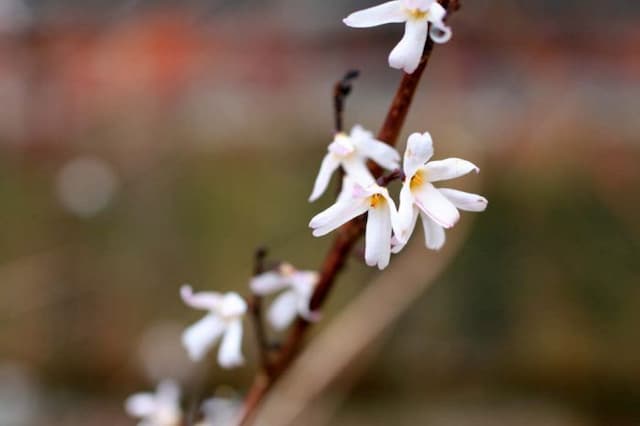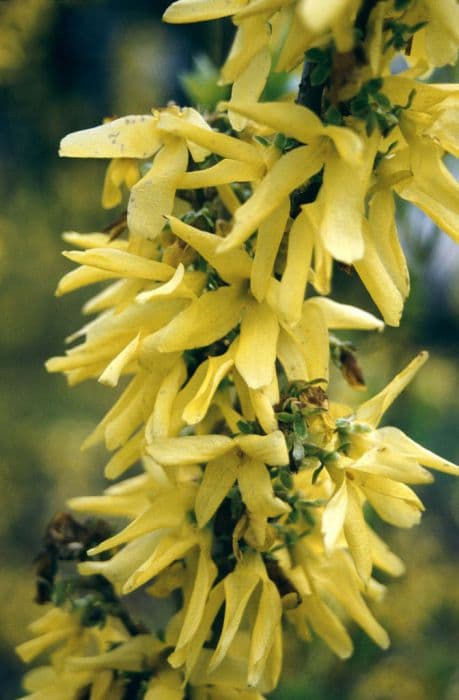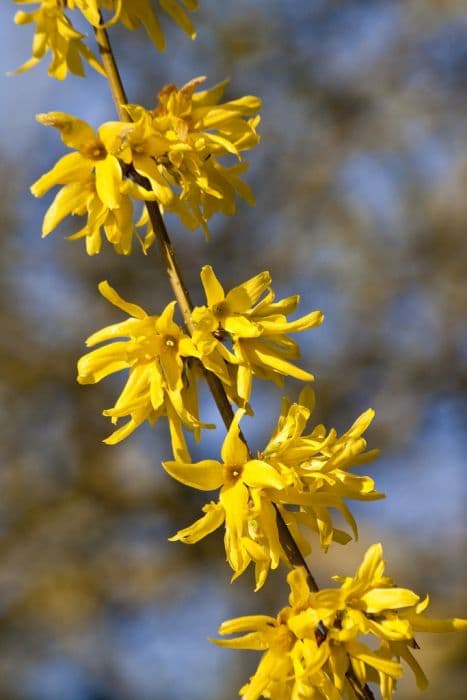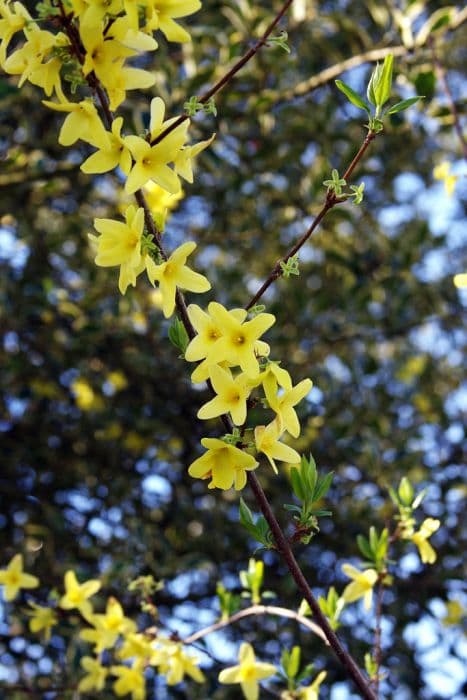Variegated False Holly Osmanthus heterophyllus 'Aureomarginatus' (v)

ABOUT
The plant commonly known as 'False Holly' has distinctive glossy, dark green leaves with spiny edges, resembling those of a holly. A striking feature of this variety is the golden-yellow edges that outline the leaves, creating an attractive variegation that adds color and contrast to the foliage. The leaves are oval in shape and can appear both as simple leaves and as those with three or five lobes, much like the classic holly leaf shape. During the blooming period, the False Holly produces small, white, fragrant flowers, which are subtly hidden among the leaves. These blossoms may not be very conspicuous, but they add a sweet scent to the garden when they appear. Following the flowers, the plant may produce small, blue-black berries that can attract birds and wildlife to the garden. Overall, the False Holly is admired for its vibrant foliage and textural appearance, with its striking variegated leaves providing year-round interest.
About this plant
 Names
NamesFamily
Oleaceae.
Synonyms
Variegated False Holly, Variegated Holly Olive.
Common names
Osmanthus heterophyllus var. aureomarginatus, Osmanthus heterophyllus 'Tricolor', Osmanthus aquifolium var. aureo-marginatus, Ilex aquifolium var. aureo-marginatus, Osmanthus ilicifolius var. aureo-marginatus.
 Toxicity
ToxicityTo humans
The False Holly is generally considered non-toxic to humans. While it is not edible and should not be ingested, there are no commonly reported symptoms of poisoning from consuming this plant. There may be individual cases of sensitivity or allergic reaction, but such occurrences are rare. Consequently, accidental ingestion of the False Holly is unlikely to cause significant harm, but as with any non-food plant, it is advisable to exercise caution and prevent ingestion, especially with children.
To pets
The False Holly is typically considered non-toxic to pets as well. This means it should not cause serious harm if pets happen to ingest the leaves or other parts of the plant. Although not poisonous, it's still best practice to prevent pets from eating plants as they might cause mild gastrointestinal upset or an allergic reaction in some sensitive individuals. However, the risk of serious toxicity from the False Holly is low for pets.
 Characteristics
CharacteristicsLife cycle
Perennials
Foliage type
Evergreen
Color of leaves
Variegated
Flower color
White
Height
6-10 feet (1.8-3 m)
Spread
5-8 feet (1.5-2.4 m)
Plant type
Shrub
Hardiness zones
7
Native area
Asia
Benefits
 General Benefits
General Benefits- Ornamental value: The plant has attractive, gold-edged leaves, which add a splash of color and texture to gardens and landscapes.
- Low maintenance: As a hardy and adaptable shrub, it requires minimal pruning and care once established.
- Drought tolerance: Once established, the plant has a good level of drought resistance, making it a solid choice for water-efficient gardening.
- Wildlife attraction: The fragrant flowers attract pollinators like bees, providing ecological benefits for garden biodiversity.
- Evergreen nature: It maintains its foliage throughout the year, providing consistent greenery and structure to garden spaces.
- Versatility in landscaping: The plant can be used for hedges, screens, or as a standalone specimen, providing flexibility in garden design.
- Cold hardiness: The plant is relatively cold hardy, making it suitable for growing in a variety of climates without significant winter damage.
- Non-invasive: The plant is a well-behaved garden resident, without tendencies to become invasive or overtake neighboring plants.
 Medical Properties
Medical PropertiesThis plant is not used for medical purposes.
 Air-purifying Qualities
Air-purifying QualitiesThis plant is not specifically known for air purifying qualities.
 Other Uses
Other Uses- Floral Arrangements: The variegated leaves of the False Holly add a unique texture and color contrast to bouquets and floral displays.
- Bonsai: False Holly can be trained into a bonsai form, offering an interesting and evergreen miniature tree for enthusiasts.
- Topiary: The dense foliage and slow growth habit make it suitable for topiary, enabling gardeners to create living sculptures.
- Natural Dye: Although not widely documented, the leaves potentially could be used to produce a natural dye for fabric or crafts.
- Cultural Significance: In some East Asian cultures, the plant is used in festival decorations or given as a gift during certain celebrations.
- Privacy Screens: Its dense growing habit allows False Holly to be planted as a privacy hedge in gardens and urban spaces.
- Wildlife Shelter: The thick foliage offers shelter and nesting sites for birds and other small wildlife.
- Erosion Control: Its root system can help stabilize soil on slopes and prevent erosion.
- Sound Barrier: When planted in large numbers, the False Holly can help reduce noise pollution from roads or neighbors.
- Culinary Garnish: Although not commonly consumed, the leaves could be used as a garnish for speciality culinary presentations for its visual appeal.
Interesting Facts
 Feng Shui
Feng ShuiThe plant_name is not used in Feng Shui practice.
 Zodiac Sign Compitability
Zodiac Sign CompitabilityThe plant_name is not used in astrology practice.
 Plant Symbolism
Plant Symbolism- Beauty: Osmanthus is often valued for its delightful fragrance and attractive foliage, symbolizing physical and aesthetic beauty.
- Nobility: In traditional Chinese culture, osmanthus is associated with nobility and high status, as it often grows in royal gardens.
- Good Fortune: The sweet scent of osmanthus is believed to bring good fortune and positive outcomes to those who encounter it.
- Romantic Love: With its intoxicating fragrance and delicate flowers, osmanthus can represent romance, love, and attraction.
- Peace: The soothing qualities of the osmanthus’ scent are considered symbolic of peace and tranquility.
 Water
WaterThe False Holly or Variegated Osmanthus requires consistent moisture, but it is important not to overwater. This plant should be watered thoroughly, ensuring that water reaches the root zone, approximately once a week. During the growing season, keep the soil evenly moist, but not soggy. In winter, you can reduce watering to every two weeks, depending on the climate. A rough estimate is to provide about 1 gallon of water per week during the active growing season.
 Light
LightThe Variegated Osmanthus thrives in partial shade to full sun. For optimal growth and foliage color, a spot that receives morning sun with dappled afternoon shade is ideal. However, the plant can also adapt to full sun conditions, as long as it is not exposed to the harsh afternoon sun in very hot climates.
 Temperature
TemperatureVariegated Osmanthus prefers moderate temperatures ranging between 60 and 80 degrees Fahrenheit but can withstand temperatures as low as 10 degrees Fahrenheit and as high as 100 degrees Fahrenheit for short periods of time. The ideal temperature range for this plant to flourish should avoid prolonged exposure to extreme heat or cold.
 Pruning
PruningPruning the Variegated Osmanthus is beneficial for shaping the plant and encouraging new growth. Prune in the late winter or early spring before new growth starts. Thinning out old branches and cutting back overgrown parts help maintain the plant's form and size. Pruning is generally done once a year, but the plant can tolerate additional light pruning if needed.
 Cleaning
CleaningAs needed
 Soil
SoilThe best soil mix for the False Holly is well-draining with plenty of organic matter. Aim for a slightly acidic to neutral pH, around 6.0 to 7.5. Incorporate compost or peat moss into the potting mix and ensure good aeration to support healthy root growth.
 Repotting
RepottingThe False Holly should be repotted every two to three years. This allows for fresh soil and room for root growth. It's best to repot in early spring before the growing season.
 Humidity & Misting
Humidity & MistingFalse Holly thrives in moderate to high humidity levels. While it can tolerate lower humidity, aim for around 40-50% for optimal growth.
 Suitable locations
Suitable locationsIndoor
Provide bright, indirect light and moderate humidity for indoor False Holly.
Outdoor
Plant in partial shade and moist, well-drained soil for outdoor False Holly.
Hardiness zone
7-9 USDA
 Life cycle
Life cycleThe life of a False Holly (Osmanthus heterophyllus 'Aureomarginatus' (v)) begins with seed germination, which requires a period of cold stratification to break dormancy. Following germination, the seedling emerges and develops into a young plant with distinctive spiny, variegated leaves edged in gold. As it matures, False Holly becomes a dense, evergreen shrub that can reach up to 10-15 feet tall and 6-8 feet wide, with slow to moderate growth rate. During its adult stage, it produces small, white, highly fragrant flowers in late summer or early fall, which are then pollinated by insects. Following pollination, berry-like fruits may develop, which mature to a dark color, containing seeds that can disperse to produce new plants. The mature False Holly can live for many years, with little maintenance required, other than occasional pruning to maintain shape and remove any dead or diseased wood.
 Propogation
PropogationPropogation time
Spring-Early Summer
Propogation: The Golden Variegated Holly, known botanically as Osmanthus heterophyllus 'Aureomarginatus', is most commonly propagated through semi-hardwood cuttings. The best time to take these cuttings is in the late summer after the season's new growth has begun to harden. A 4 to 6 inch cutting with several leaf nodes is ideal, stripped of its lower leaves and dipped in rooting hormone. This cutting should then be inserted into a well-draining potting mix and kept in high humidity conditions, such as under a plastic cover, to prevent moisture loss. Rooting typically occurs within 6 to 8 weeks, after which the new plant can be gradually acclimatized to less controlled conditions.








